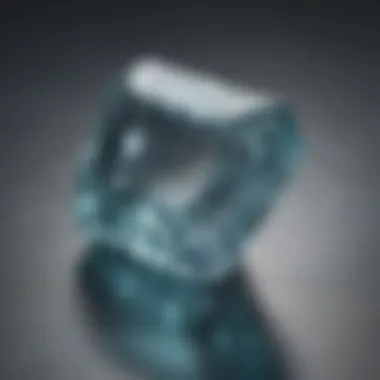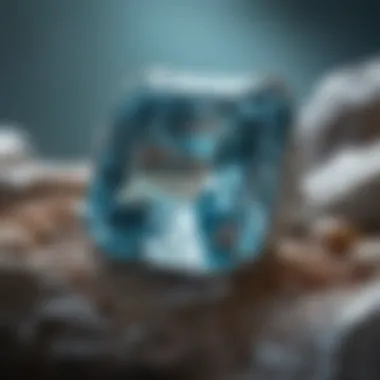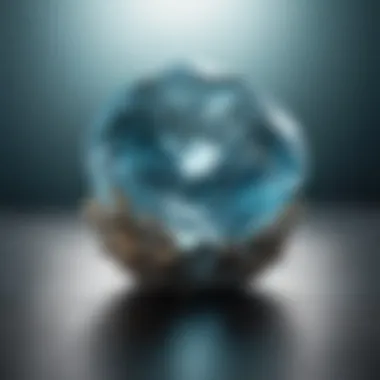Exploring the Beauty and Benefits of Clear Aquamarine


Intro
Clear aquamarine is a fascinating gemstone that captivates both enthusiasts and casual admirers alike. With its serene color reminiscent of tranquil seas, it has secured its place in the pantheon of prized gems. This article will delve into the unique characteristics of clear aquamarine, exploring its origins, properties, and uses in both jewelry and therapeutic fields. From its historical significance to its chemical makeup and care methods, we aim to provide a detailed and informative guide for those interested in this splendid gemstone.
Gemstone Overview
Description of the gemstone
Clear aquamarine is a variety of beryl, known for its delicate blue-green color. Its name originates from the Latin words for seawater, highlighting its oceanic hue. The clarity of a well-cut aquamarine enhances its visual appeal, allowing light to pass through and create a captivating glow. This gemstone often exhibits excellent clarity and transparency, making it highly sought after for jewelry applications.
Physical properties
Aquamarine has several notable physical properties:
- Chemical composition: Primarily composed of beryllium aluminum silicate (Be3Al2(SiO3)6).
- Hardness: Rated 7.5 to 8 on the Mohs scale, it boasts ample durability.
- Crystal system: Hexagonal, typically forming prismatic crystals.
- Color range: While most known for its clear blue shades, it can also appear in greenish hues.
These attributes contribute to the overall allure and desirability of clear aquamarine among collectors and jewelry designers.
Healing Properties
Metaphysical attributes
Many believe that clear aquamarine carries distinct metaphysical properties. Said to embody calming energies, it is often associated with tranquility and serenity. Those who use aquamarine in spiritual practices claim it promotes emotional balance and clarity of thought. This gemstone is also thought to enhance communication, making it a favorite among those seeking to improve their speaking or interpersonal skills.
Common uses in holistic practices
In the realm of holistic wellness, clear aquamarine finds its niche in various applications, such as:
- Meditation: Many use aquamarine during meditation to enhance focus and facilitate a tranquil state of mind.
- Crystal healing: Often placed on or near the body, it is believed to foster emotional healing and relieve stress.
- Jewelry: Worn as pendants or bracelets, aquamarine jewelry is said to offer protective qualities and emotional stability.
This unique combination of aesthetic beauty and supposed healing properties makes clear aquamarine a versatile choice for both fashion and wellness enthusiasts.
"Clear aquamarine, with its striking colors and purported powers, is a coveted gem in various cultures, symbolizing peace and clarity."
As we continue further, we will explore the historical significance of this gemstone, delve into identification methods, and discuss proper care techniques to maintain its beauty.
Preface to Clear Aquamarine
Clear aquamarine is a fascinating gemstone that attracts gemstone enthusiasts and collectors alike. This article delves into its properties, origins, uses, and the allure that makes clear aquamarine noteworthy in both gemology and aesthetic value. Understanding this stone helps enthusiasts recognize its impact both in jewelry and therapeutic contexts.
Definition of Clear Aquamarine
Clear aquamarine is a variety of the mineral beryl, characterized by its stunning blue to blue-green hue. The term "aquamarine" is derived from Latin, meaning "water of the sea." This name reflects the stone’s unique color reminiscent of tranquil ocean waters. Clear aquamarine is defined by its clarity, lack of inclusions, and light shades, which distinguish it from darker or more included forms of beryl. The value of clear aquamarine often lies in its transparency and the subtle richness of its color.
Significance in Gemology
In gemology, clear aquamarine is considered a precious stone due to its combination of aesthetic appeal and durability. It ranks 7.5 to 8 on the Mohs scale of hardness, making it a viable choice for various jewelry applications, including rings, necklaces, and earrings.
Moreover, besides its physical properties, clear aquamarine has significant symbolic meaning. Many cultures associate it with serenity, clarity, and communication. It is often believed to have calming effects, making it a sought-after stone not just for adornment but also for wellness practices.
Clear aquamarine embodies ease and tranquility, reflecting both its serene color and the peace it is thought to impart.


The allure of clear aquamarine is not solely its physical beauty. It serves as a testament to natural formation processes that yield gemstones, providing an insight into geological history. This dual significance as a mineral specimen and decorative stone places clear aquamarine at a coveted position in both gem collecting and jewelry making.
Origins of Clear Aquamarine
The origin of clear aquamarine is crucial to understanding its unique characteristics and value. This gemstone, valued for its clarity and calming blue hue, has a rich history interconnected with geological processes and cultural significance. Knowing where and how aquamarine is formed helps not only in appreciating its beauty but also in recognizing the implications for collectors and jewelers alike in terms of authenticity, sourcing, and value.
Geological Formation
Clear aquamarine is a variety of beryl, a mineral compound of beryllium aluminum silicate. Its formation takes place in pegmatites, which are coarse-grained igneous rocks. During the cooling process of magma, these rocks allow for the slow crystallization of minerals, leading to the formation of large, well-defined crystals. Aquamarine specifically forms under high-temperature and pressure conditions, typically in granitic areas.
The defining element that gives aquamarine its blue to blue-green color is iron. When iron is present in the beryl structure, it interacts with the crystal lattice and causes the striking shades associated with aquamarine. This chemical composition is crucial, as it directly affects the gemstone's optical properties and overall appearance.
Major Sources
Aquamarine is mined in various locations around the world. Notable sources include:
- Brazil: Home to some of the largest and most beautiful aquamarine specimens, particularly from Minas Gerais.
- Nigeria: Known for producing high-quality and deep-colored aquamarines.
- Madagascar: Offers a variety of shades and a significant amount of crystal clarity.
- Pakistan: The Skardu region produces some exceptional aquamarine crystals, notable for their size and quality.
Each region contributes distinct characteristics to its aquamarine. For example, Brazilian aquamarine tends to have clearer and larger stones, while Nigerian variants may exhibit a deeper, richer color. These details are important for gem enthusiasts and jewelers when evaluating the quality and potential applications of the stone.
Historical Context
Aquamarine has a rich historical tapestry woven through various cultures. The name "aquamarine" comes from the Latin word meaning "water of the sea," which reflects its color. In ancient lore, it was believed to be the treasure of mermaids, symbolizing protection and safety at sea. It was favored by sailors, who would carry it as a talisman against perilous voyages.
Moreover, aquamarine has been associated with various attributes across cultures. In the Middle Ages, it was thought to have healing properties, particularly for ailments related to the throat and respiratory system. In modern times, it maintains its allure as a birthstone for March, symbolizing serenity and fidelity. These cultural associations add to the importance and appeal of aquamarine, making it not only a jewel of beauty but also one rich in meaning.
"Aquamarine is often regarded as a stone of courage, helping to overcome fear and promoting tranquility."
The origins of clear aquamarine encompass geological, geographical, and historical dimensions. Collectively, they contribute to a comprehensive understanding of this fascinating gemstone, enabling enthusiasts to appreciate not just its aesthetic value, but also its significance throughout history.
Physical Properties of Clear Aquamarine
Understanding the physical properties of clear aquamarine is essential for anyone interested in this gemstone. These characteristics not only determine the aesthetic appeal but also impact the practical aspects during use, whether in jewelry or therapeutic contexts. Clear aquamarine, a member of the beryl family, exhibits properties that make it unique and desirable among gemstone enthusiasts and collectors.
Chemical Composition
Clear aquamarine is primarily composed of beryllium aluminum silicate, with the chemical formula Be3Al2(SiO3)6. This composition contributes to its distinct blue color, which can range from pale to deep blue, influenced by the presence of iron traces. The purity of the gemstone also plays a significant role in determining its hue, clarity, and overall visual qualities.
The presence of iron is significant as it affects the color, and the absence of inclusions results in a remarkably transparent stone. This clarity not only enhances the visual beauty but also makes it highly sought after in jewelry making. Aquamarine’s chemical structure closely relates to its durability and resistance to various forms of wear and tear.
Hardness and Durability
The Mohs scale of mineral hardness classifies clear aquamarine at a 7.5 to 8. This score indicates a good level of hardness, making it suitable for everyday wear in jewelry. Its resistance to scratching and chipping ensures longevity, a crucial aspect for collectors and designers alike.
However, it's important to note that, while durable, caution should still be exercised. Prolonged exposure to harsh chemicals and extreme temperature changes can potentially damage the stone. Ensuring the proper care will sustain its beauty and structural integrity over time.
Optical Characteristics
The optical properties of clear aquamarine play an essential role in how the gemstone is perceived. It exhibits strong pleochroism, meaning it can show different colors when viewed from different angles.
Key optical characteristics include:
- Color: Ranges from pale blue to deep blue, influenced by the iron content.
- Clarity: High-quality aquamarine stones are known for their exceptional clarity, making them desirable for jewelers.
- Brilliance: The stone can exhibit a significant degree of brilliance due to its excellent light dispersion, enhancing its aesthetic appeal.


"High-quality aquamarine is prized for its clarity and brilliance, making it a favorite in fine jewelry."
These optical properties not only heighten the allure of clear aquamarine but also provide an opportunity for designers to showcase their creativity. Understanding these elements allows enthusiasts to appreciate the gemstone beyond its superficial beauty.
Uses of Clear Aquamarine
Clear aquamarine, a gem known for its serene blue hues and clarity, has significant applications that span multiple domains. Understanding these uses is crucial for both gem enthusiasts and collectors, as it emphasizes the gemstone's diverse value beyond mere aesthetics. Its properties lend themselves to jewelry, healing, and cultural expressions, making it an essential topic in any comprehensive study of clear aquamarine.
Jewelry Applications
In the world of jewelry, clear aquamarine occupies a distinguished position. Its striking color complements various metals, such as white gold and platinum. The gem is often cut into elegant shapes and forms, including ovals, rounds, and emerald cuts, showcasing its brilliance and transparency.
Consumers frequently seek aquamarine for engagement rings, necklaces, and earrings. The gemstone’s moderate hardness, rated 7.5 to 8 on the Mohs scale, adds durability, making it suitable even for daily wear. Notably, its calming blue color is believed to symbolize peace and tranquility, enhancing its appeal in bridal jewelry.
"Aquamarine jewelry not only captivates the eye but also embodies emotional connections."
In addition, jewelry designers are increasingly integrating clear aquamarine into bespoke collections. The stone's versatility allows designers to experiment with various styles—vintage, modern, or even minimalist. Despite the competition from more widely known gemstones, aquamarine stands out due to its unique hue and connection to the sea.
Therapeutic Benefits
Apart from its aesthetic charm, clear aquamarine is praised for its reputed therapeutic benefits in holistic practices. Many believe that it can promote emotional healing, reduce stress, and alleviate fears. This connection to wellness is where aquamarine aligns closely with practices such as crystal healing and meditation. Those who utilize aquamarine often claim that it can enhance communication and foster a calming environment, important for those in the healing professions like therapy or coaching.
Some proponents suggest placing the stone on the throat chakra to experience its purported benefits. This practice is rooted in the belief that aquamarine can assist in clear expression, enabling deeper connections with oneself and others. For those exploring holistic lifestyles, clear aquamarine provides an appealing avenue for emotional and mental support.
Cultural Significance
Historically, clear aquamarine has held cultural significance across various civilizations. Sailors in ancient times carried the gemstone as a talisman, believing it could protect them at sea. This belief underscores aquamarine's connection to water and reflects how cultures have woven its narrative into their fabric.
Additionally, clear aquamarine is often associated with the month of March, where it symbolizes courage and clarity. It is a popular choice for birthdays and anniversaries, particularly in the context of the 19th anniversary. The cultural narratives imbued in aquamarine resonate at personal and societal levels, showcasing its enduring relevance.
In modern contexts, aquamarine is often featured in art and fashion, celebrated for its elegance and subtle charm. Whether as a focal point in jewelry or as a source of inspiration in artistic endeavors, clear aquamarine continues to captivate and contribute to our collective cultural heritage.
Identification of Clear Aquamarine
Understanding how to identify clear aquamarine is essential for anyone involved in gemstones, whether for personal collection or professional purposes. Clear aquamarine possesses unique characteristics that distinguish it from other gemstones. Proper identification not only protects investments but also enhances appreciation for its beauty and qualities.
Tools for Identification
Several tools are available to assist in the identification of clear aquamarine. These tools help examine the gem's physical properties and distinguish it from similar stones. Some commonly used tools include:
- Gem microscope: This tool magnifies the gemstone, allowing for a close examination of its inclusions and surface features.
- Refractometer: This device measures the refractive index, which is a crucial parameter for identifying aquamarine. Aquamarine typically has a refractive index of about 1.577 to 1.583.
- Spectroscope: This instrument assesses the light absorption properties of the stone. Clear aquamarine exhibits specific absorption patterns that can confirm its identity.
- Hardness testing kit: Aquamarine ranks between 7.5 and 8 on the Mohs scale of mineral hardness. A simple scratch test with known materials can help verify this.
Using these tools in combination can provide a comprehensive understanding and help avoid misidentification.
Common Misidentifications
Clear aquamarine may be confused with several other gemstones due to their similar appearance. Knowing these potential misidentifications can help collectors and enthusiasts avoid costly mistakes. Some common stones mistaken for clear aquamarine include:
- Blue Topaz: Often, people confuse blue topaz with aquamarine because of the similar blue hues. However, blue topaz typically has a brighter, more vivid color and a different hardness.
- Cabochon Crystal Quartz: Both have a clear blue color, but quartz is significantly less valuable than aquamarine. Quartz can also feel lighter and less substantial.
- Synthetic Aquamarine: Differentiating natural and synthetic varieties can be tricky. Synthetic stones often have more consistency in color and fewer inclusions.
"Proper identification requires careful observation and sometimes the right tools to discern the subtleties between different gemstones."


By understanding the nuances and investing time in the identification process, enthusiasts can enhance their appreciation for clear aquamarine while ensuring they possess authentic gems.
Caring for Clear Aquamarine
Caring for clear aquamarine is crucial for maintaining its beauty and longevity. This gemstone, celebrated for its transparent blue hues, requires specific attention to preserve its allure. Whether it's used in jewelry or kept as a collectible, understanding the proper care techniques is essential for every enthusiast or owner.
Cleaning Techniques
To ensure clear aquamarine retains its vibrant appearance, regular cleaning is necessary. The cleaning method should be gentle yet effective. Here are some recommended techniques:
- Warm Soapy Water: Mix mild dish soap with warm water. Use a soft cloth or a brush with gentle bristles to gently scrub the gem. Avoid harsh chemicals which can damage the stone.
- Ultrasonic Cleaners: These devices can be used, but caution is advised. Ensure the aquamarine is not treated or has any inclusions. If unsure, stick to manual cleaning methods.
- Soft Cloth Drying: After washing, dry the gemstone with a soft, lint-free cloth. Make sure no moisture is left that could cloud its clarity.
"With the right care, clear aquamarine can sparkle brilliantly for generations to come."
Storage Guidelines
Proper storage is key to preventing damage and maintaining the integrity of clear aquamarine. Here are some guidelines to consider:
- Separate Storage: Store aquamarine separately from other gemstones to avoid scratches. Use a soft pouch or a lined jewelry box.
- Avoid Extreme Temperatures: Keep aquamarine away from extreme heat or cold, which can cause cracks or discoloration.
- Humidity Control: Ensure the storage area has moderate humidity. Too much moisture can lead to cloudiness in the stone.
By following these cleaning techniques and storage guidelines, clear aquamarine will continue to exude its captivating charm, assuring its value and appeal remains intact. Proper care not only enhances the beauty of the gemstone but also respects its natural properties, making it a worthy possession.
Market Trends for Clear Aquamarine
Understanding market trends for clear aquamarine is essential for enthusiast, collector, and jewelry designer. This segment sheds light on the unique aspects that influence the demand, pricing, and overall status of this remarkable gemstone. Recognizing these trends allows stakeholders to make informed decisions, whether in purchasing, selling, or investment.
Current Market Value
The current market value of clear aquamarine can vary significantly based on several factors. Generally, the quality, size, and clarity of the stone directly influence its price. Top-tier aquamarines are usually vivid blue to blue-green, and the absence of inclusions contributes to their elevated value.
Other specific aspects can impact the market value:
- Origin: Stones from well-known mines often carry a premium due to their reputation. For example, aquamarine sourced from Brazil tends to command higher prices.
- Carat Weight: Larger stones are rarer. Consequently, they fetch more in the market than smaller ones.
- Treatment: Many aquamarines go through treatments to enhance their color. Untreated stones are generally valued higher.
According to current market reports, prices can range from $100 to over $500 per carat, depending on the above factors. Monitoring auction sites and gemstone dealers can provide insight into ongoing pricing trends.
Investment Potential
Investing in clear aquamarine offers potential for growth but comes with certain considerations. The popularity of aquamarine among collectors and jewelry designers supports its investment appeal. As the global demand for colored gemstones continues to rise, well-chosen aquamarine pieces can appreciate over time.
Key points to consider when evaluating the investment potential:
- Rarity: High-quality aquamarine is not as common as other gemstones. Scarcity can drive prices up, especially for exceptional specimens.
- Market Conditions: The gemstone market can react sensitively to economic conditions. Keeping an eye on the broader economic influences can help gauge future price movements.
- Market Trends: Understanding fashion trends in jewelry can aid in making timely acquisition decisions. Gemstones that align with consumer preferences are likely to see increased value.
Investors should also consider reputable sources and possibly consult gemstone experts to evaluate specific pieces. Building a curated collection of aquamarine may not only result in aesthetic enjoyment but also financial gain.
"Quality aquamarine is the epitome of elegance and a sound investment, offering both beauty and potential financial return."
End
The conclusion of this article encapsulates the multifaceted world of clear aquamarine, emphasizing its significance beyond mere aesthetics. Clear aquamarine captivates not just because of its enchanting beauty, but also due to its rich history and diverse properties. As we explore its various facets, it becomes apparent that aquamarine is not just a gemstone, but also a symbol of deeper meanings connected to both personal and cultural narratives.
Summary of Key Points
- Clear aquamarine is defined by its striking blue or greenish-blue hues, resulting from its chemical composition of beryllium aluminum silicate.
- The gemstone's hardness and durability make it suitable for various jewelry applications, ensuring longevity and resilience in wear.
- Major sources of clear aquamarine include Brazil, Nigeria, and Madagascar, each contributing unique qualities to the stone.
- Historically, aquamarine has been revered for its supposed calming effects, making it a popular choice in therapeutic practices.
- Identifying authentic aquamarine can be challenging, with tools such as refractometers and polariscopes essential for gemologists, while being aware of common misidentifications can safeguard against fraud.
- Proper care of aquamarine involves regular cleaning and appropriate storage, maximizing the gemstone’s allure over time.
- The market for clear aquamarine reflects trends that showcase its investment potential alongside its popularity in the luxury jewelry sector.
Final Thoughts on Clear Aquamarine
In summation, clear aquamarine serves as a reminder of nature's artistry and geological processes, combining beauty with a wealth of meanings. Enthusiasts, collectors, and designers alike can appreciate the balance of allure and practicality that clear aquamarine offers. By understanding its unique properties, cultural significance, and proper care, one can fully grasp the value of this exquisite gemstone. Whether worn as jewelry or utilized in therapeutic contexts, clear aquamarine remains a valuable addition to anyone's collection or practice, embodying both elegance and depth.







